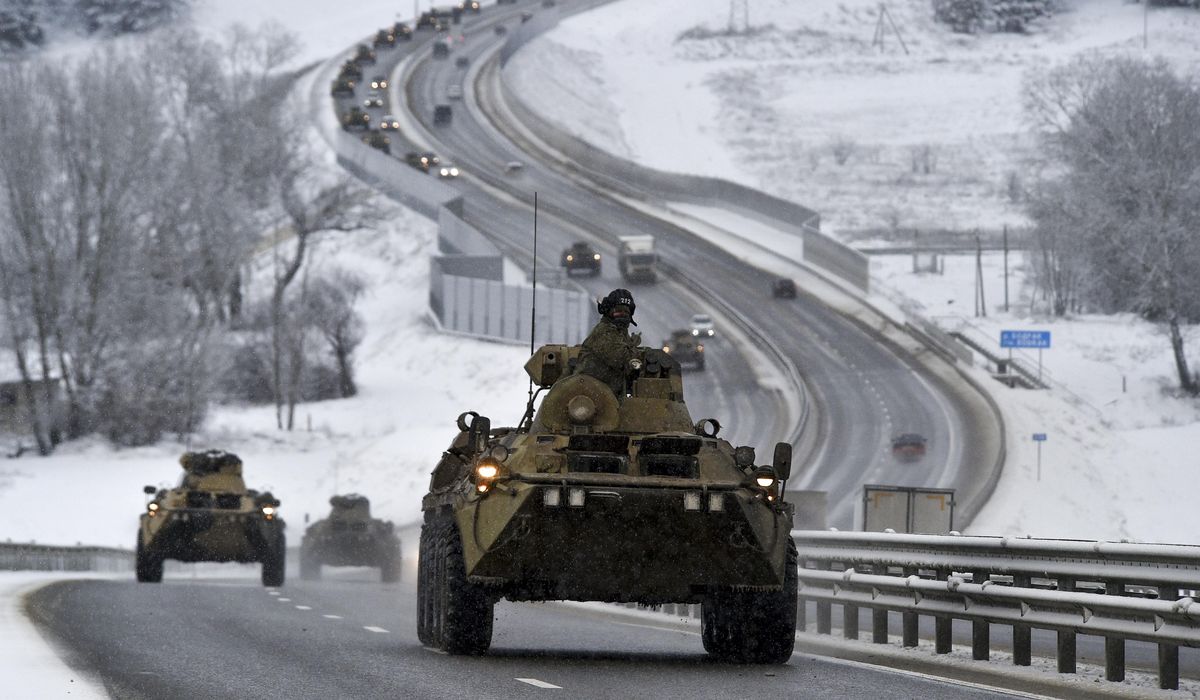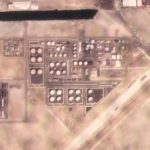
The Biden administration’s scramble to prevent a Russian military invasion of Ukraine will shift into high gear Wednesday, with Secretary of State Antony Blinken visiting Kyiv to show support for the Ukrainian government before holding a high-stakes summit with Russian Foreign Minister Sergey Lavrov later in the week.
The flurry of shuttle diplomacy comes as Russia and Belarus — another authoritarian former Soviet republic that Russian President Vladimir Putin has sought to draw into Moscow’s orbit in recent years — say they will begin holding joint military exercises near the Belarus-Ukraine border and not far from the borders of NATO members Poland and Lithuania.
With Russian military equipment rumbling into Belarus and further elevating regional tensions over Moscow’s separate massing of 100,000 troops along Russia’s border with Ukraine, U.S. officials warned that Mr. Putin has generated a “crisis” to justify a potential invasion akin to what he pulled off in 2014 when Moscow forcefully annexed the Crimean Peninsula from Ukraine.
The Kremlin denies any plans to invade Ukraine and accuses NATO of sparking the crisis by moving its forces and arms nearer to Russia’s borders and refusing to rule out membership for former Soviet states such as Ukraine and Georgia. The Biden administration says it is Mr. Putin who is exacerbating tensions and making it hard to strike a diplomatic resolution.
“This includes moving Russian forces into Belarus over the weekend — this is neither an exercise nor normal troop movement,” a senior State Department official in Washington told reporters on a background conference call. “It is a show of strength designed to cause or give a false pretext for a crisis as Russia plans for a possible invasion. And let’s be clear: This is extremely dangerous. We are now at a stage where Russia could, at any point, launch an attack on Ukraine.
“We are very alert to everything that Russia is doing,” the official said. “The fact that we’re seeing this movement of forces into Belarus clearly gives the Russians another approach should they decide to take further military action against Ukraine. We are concerned across several dimensions about Russia creating a pretext for a possible invasion.”
The Biden administration has stopped short of outlining what action it is willing to take to prevent Mr. Putin from repeating the events of 2014. Administration officials have said only that Russia would face “massive consequences,” with the U.S. and its European allies likely to work together to impose severe sanctions on Moscow and ramp up the flow of military equipment to the Ukrainian army if Russia invades.
White House press secretary Jen Psaki underscored the urgency. “We’re now at a stage where Russia could at any point launch an attack in Ukraine,” she said. “What Secretary Blinken is going to do is highlight very clearly there is a diplomatic path forward.”
Putin’s plans
That path right now is not clear. The U.S. and Russia appear poised to continue wrestling over Ukraine, a fledgling democracy that has been a staging ground of geopolitical friction between Washington and Moscow since shortly after the early-1990s end of the Cold War.
U.S. officials say they have not concluded whether Mr. Putin plans to invade or whether the show of force is intended to squeeze security concessions without a conflict. Russia has brushed off NATO and U.S. pressure to withdraw its troops, saying Moscow has a right to deploy forces wherever it likes inside its territory.
Washington and its allies firmly rejected Moscow’s demands during a round of Russian-U.S. negotiations in Geneva and a related NATO-Russian meeting in Brussels last week. Administration officials say there is room to discuss demilitarization moves across Russia’s tense western border.
The White House announced Friday that U.S. intelligence officials had determined that a clandestine operation was underway to create a pretext for Russian troops to invade Ukraine.
Ms. Psaki told reporters that the intelligence findings indicated that Moscow was positioning operatives to conduct “a false-flag operation” in eastern Ukraine, where a Moscow-backed Ukrainian separatist movement has been battling the Western-backed Kyiv government for eight years. She said Russia is also laying the groundwork through a social media disinformation campaign that frames Ukraine as an aggressor preparing an imminent attack against the separatist enclave in eastern Ukraine.
The Putin government has rejected the White House accusations, while Russian troops massed near the Ukrainian border have engaged in fresh exercises that the Kremlin claims are purely defensive.
Mr. Lavrov told reporters in Moscow on Monday that the U.S. claims were “total disinformation.” He reaffirmed that Russia expects a written response this week from the U.S. and its allies to Moscow’s request for binding guarantees that NATO will not embrace Ukraine or any other former Soviet nations or station its forces and weapons in such nations.
Mr. Blinken is slated to hold a high-stakes summit with Mr. Lavrov on Friday in Geneva. The senior State Department official who briefed reporters Tuesday said the meeting will focus on testing “whether there is an opportunity for a diplomatic off-ramp” to the rising tensions over Ukraine.
Mr. Blinken is headed to Europe a week after Deputy Secretary of State Wendy Sherman met with her Russian counterpart in Geneva as well as with NATO allies in a bid to tamp down tensions with Moscow.
“If Russia does decide to pursue further military aggression, if it chooses to further escalate, we have been working very closely and effectively with our allies and our partners to ensure that there would be massive consequences,” said the senior State Department official.
The department announced earlier Tuesday that Mr. Blinken was heading to Ukraine and then Germany before gathering with Mr. Lavrov. German Foreign Minister Annalena Baerbock was in Moscow on Tuesday for talks with the Russian foreign minister.
The new German government of Chancellor Olaf Scholz has hinted strongly that it would shut down the planned Nord Stream 2 gas pipeline linking Russia and Germany — a long-sought project for Mr. Putin — if Moscow moves against Ukraine.
State Department spokesperson Ned Price said Mr. Blinken would begin his trip in Kyiv, meeting with President Volodymyr Zelenskyy and Foreign Minister Dmytro Kuleba on Wednesday to “reinforce the United States’ commitment to Ukraine’s sovereignty and territorial integrity.”
On Thursday, Mr. Blinken is set to travel to Berlin to “discuss recent diplomatic engagements with Russia and joint efforts to deter further Russian aggression against Ukraine, including allies’ and partners’ readiness to impose massive consequences and severe economic costs on Russia,” Mr. Price said.
• This article is based in part on wire service reports.








